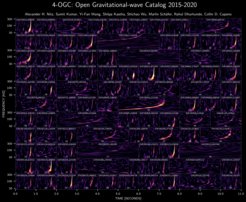Open gravitational-wave catalog no. 4
New independent analysis of public LIGO/Virgo data by AEI researchers identifies 94 signals, 7 of which not reported previously
A team of researchers from the Max Planck Institute for Gravitational Physics (Albert Einstein Institute; AEI) in Hannover have published their fourth Open Gravitational-wave Catalog (4-OGC) based on public LIGO/Virgo data from the O1, O2, O3a, and O3b observing runs. Their independent search finds 90 binary black hole mergers, 2 binary neutron star mergers, and 2 neutron-star–black-hole mergers; the largest collection of mergers to date. Their results are broadly consistent with those of the LIGO/Virgo GWTC-3 catalog. They find 7 new discoveries not reported elsewhere with high significance. The researchers make available their comprehensive catalog of 94 signals and numerous sub-threshold candidates online.
Paper abstract
We present the fourth Open Gravitational-wave Catalog (4-OGC) of binary neutron star (BNS), binary black hole (BBH) and neutron star-black hole (NSBH) mergers. The catalog includes observations from 2015-2020 covering the first through third observing runs (O1, O2, O3a, O3b) of Advanced LIGO and Advanced Virgo. The updated catalog includes 7 BBH mergers which were not previously reported with high significance during O3b for a total of 94 observations: 90 BBHs, 2 NSBHs, and 2 BNSs. The most confident new detection, GW200318_191337, has component masses 49.1+16.4−12.0 M⊙ and 31.6+12.0−11.6 M⊙; its redshift of 0.84+0.4−0.35 (90% credible interval) may make it the most distant merger so far. We provide reference parameter estimates for each of these sources using an up-to-date model accounting for instrumental calibration uncertainty. The corresponding data release also includes our full set of sub-threshold candidates.













